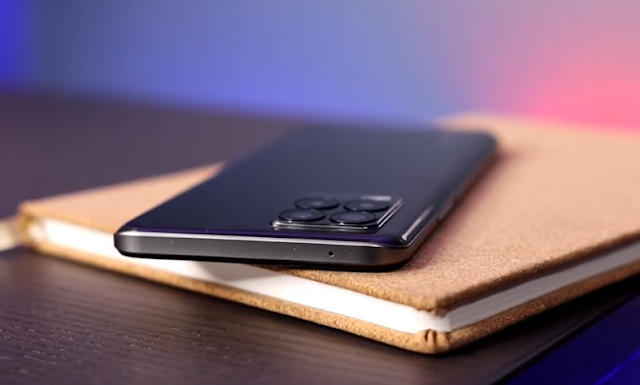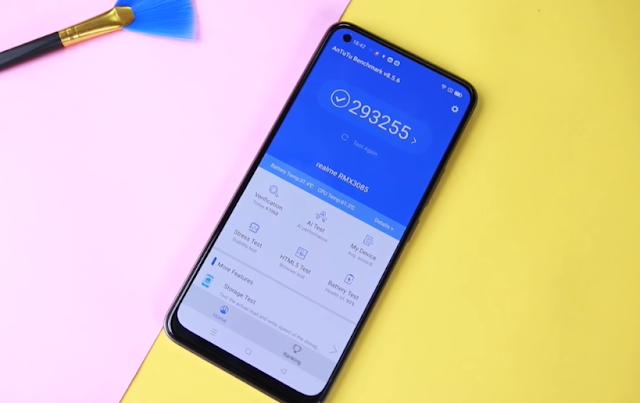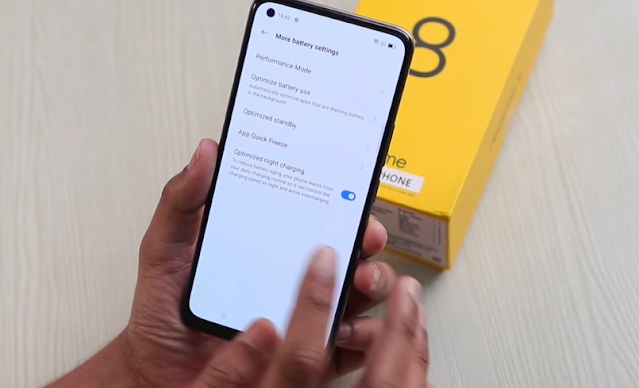Realme 8 brings a good new design and an AMOLED display.
Realme came up with many smartphones in the mid-range as well as the premium mid-range segment with the launch of the newer Realme X7 series, the Narzo 30 series, and now the most important series, the Realme 8 series that people have been waiting for. With the Realme 8 series, Realme has brought in a newer design aspect, introduction to RealmeUI 2.0 and there is a lot of new features to look at.
The Realme 7 is still a very good mid-range smartphone that aces up the sleeves with some very good specifications like a powerful Mediatek Kelio G95 chipset, a 90Hz display, faster 30W fast charging, and a good camera setup. However, the display was IPS LCD, and the design is not so great and this is where the Realme 8 comes.
Now the Realme 8 has been launched and does not bring many upgrades over the Realme 7 (Review) except for the newer design and an AMOLED display. Other than these, would you consider it over the Realme 7 just for the AMOLED display making it the perfect mid-ranger worth buying where there are other Realme smartphones like the Realme X7 (Review) and the Realme Narzo 30 Pro (Review)?
Let’s find out in the full review.
Realme 8 Design:
The Realme 8 has a striking new design called the “Infinite Bold Design” where you are getting a dual-tone finish matte finish but the build is still polycarbonate. The Realme 8 is offered in two color variants- Cyber Black and Cyber Silver. The back also has a glossy finish that catches a lot of fingerprints.
The design has a 70-percent and 30 percent split where one part of the back houses a square-shaped camera module with an LED flash, the other part has the massive Dare To Leap logo. The back has a P2i coating which makes it splash resistant against water or can be taken in rain. The Realme 8 has a plastic frame around the sides which feels a bit cheaper.
To the right side, there are the volume buttons and a power button and to the left, there is a triple card slot that houses two SIM cards and one microSD card slot for storage expansion. At the bottom, there is a USB Type-C port, a 3.5mm headphone jack, a primary microphone, and a loudspeaker grille. To the top, there is only a secondary noise-canceling microphone.
On the front, there is a single punch-hole display with the punch hole located on the top left corner and the bezels are also slimmer except the bottom chin. This newer body makes the Realme 8 lighter compared to the Realme 7 by 20 grams as it weighs 177 grams. Talking about colors, the Cyber Silver variant has a Dare to Leap logo that shines and produces a rainbow effect making it striking to look at.
The Cyber Black looks plain and the “Dare To Leap” glows when seen at night. Overall, with the newer design, the Realme 8 does look fresher but maybe those designs are too much for some, so considering its looks, it is a mixed opinion.
Realme 8 Display:
This is where the Realme 8 feels like an upgrade over the Realme 7. The Realme 8 houses a smaller 6.44 inches Full HD+ (1080×2400 pixels) Super AMOLED display with a screen to body ratio of 20:9. The display is a shade smaller than 6.5 inches on the Realme 7 that has an IPS LCD display.
So as it an AMOLED display, the color reproduction remains excellent with great viewing angles. The smartphone supports HDR contents and Widevine L1 which makes streaming HD contents from OTT platforms much better. And since this is an AMOLED panel, the highest brightness achieved by the display is 1000nits under direct sunlight.
The display is easily visible under direct sunlight and this display can go very low in brightness and just like all other Realme smartphones, there are the Realme Labs that have DC dimming that reduces flickering of the display during the night, the display covers 96.5 percent of the DC-P3 gamut. What you get is now an Always-On display that can be customized with different designs.
It shows the date, time, and other notifications but the Always-On display stays here all the time, unlike the Redmi Note 10 where the Always-On display stays for 10 seconds. Like other AMOLED displays, there is also the OSIE visual effect which boosts the colors while watching a video and also increases the quality of the video. For example, 24fps video will be converted to 60fps while watching.
Since it has an AMOLED panel, it does miss out on the high refresh rate which its predecessor, the Realme 7 had. The Realme 8 gets a standard 60Hz refresh rate instead of the 90Hz on the Realme 7.
But the touch sampling rate is 180Hz which makes it much responsive while scrolling or playing games.
Talking about protection, Realme has gone for Gorilla Glass 3 and as this is an AMOLED display, there is an optical in-display fingerprint scanner that is quite accurate and fast. It cannot be as fast as the Redmi Note 10’s side-mounted fingerprint scanner but the face unlocks works better here. The display seems to make the Realme 8 great for media consumption.
Realme 8 Performance:
The Realme 8 runs on a similar chipset, the Mediatek Helio G95 which is also present on the Realme 7 launched last year. So the performance feels much better and all activities like scrolling through webpages, multi-tasking between applications and playing games felt smoother on the smartphone.
The RAM management has been good but some applications do load in memory after not being used for a longer amount of time.
This chipset is a powerful one when seen the benchmarks like on Geekbench 5.1, it scored 530 and 1538 in single as well as multi-core tests, and in Antutu v8, it scored 293255 which is almost closer to the benchmark scores of the Snapdragon 765G on the OnePlus Nord. Talking about gaming, all heavy games like Call Of Duty Mobile, Asphalt 9 Legends ran smoothly even at the highest graphics settings.
There was no frame drops noticed as such but the back did feel a bit warmer but now Realme has equipped a cooling chamber that can control peak temperatures during gameplay. Though you miss out on a higher refresh rate display, the touch sampling rate is at 180Hz which makes it very responsive while doing any action in the games.
The Realme 8 ships in three variants: 4/6/8GB RAM and 128GB storage with UFS 2.1 speeds. Since Realme has focussed on a gaming-centric chipset, it provides some other features for smoother gameplay like a dedicated game space tool that blocks notifications and calls while gaming, displays utilization of CPU and GPU, and also there is a performance mode which you can choose while gaming.
The performance remains excellent on the Realme 8 in the mid-range segment with good gaming capabilities.
Realme 8 Software:
The Realme 8 runs on the latest RealmeUI 2.0 based on Android 11 which comes as a relief which we had expected from the Realme X7 series. With RealmeUI 2.0, there are a host of new features. There is a new Personalization feature under settings where you can customize themes, wallpapers, icons, font size, app layouts, and also the fingerprint style much like that of OxygenOS.
There is a new enhanced Dark Mode that applies to all third-party applications and can automatically switch depending on the light intensity on the display. There are other features like a system cloner which makes a clone of a particular application and like all other Realme smartphones, there is DC dimming and Smooth Scrolling under Realme Labs.
For privacy, the smartphone has different features like an app lock, a Private Safe where you can set a pin and save your private photos, files, videos, and also the Hide Apps is also a good addition where you can hide different applications. Dual Mode audio is present where you can connect one earphone wirelessly and another wired earphone and enable streaming on both.
Other typical features are present like Digital Wellbeing which shows the battery consumed by different applications, three-finger gestures for screenshots, a smart sidebar, screen recording, put the smartphone down to mute the volume during a call or while watching a video, and double to wake or sleep for the lock screen. These small features make it quite intuitive to use.
But there are a lot of third-party applications pre-installed like Facebook, Realme Browser, Realme Store, Realme Paysa, etc that consume a lot of space and memory and can be uninstalled and other applications like HeyFun and Browser pushes a lot of notifications making the notification shade spammy. However, there are no ads present that were a part of RealmeUI 1.0.
In terms of software updates, you are guaranteed another two years of Android and security updates and RealmeUI has a good track record of updates. Overall, the RealmeUI feels much like Stock Android and also resembles more like OxygenOS thus providing a smoother and richer software experience except for some extra third-party applications that are pre-installed.
Realme 8 Cameras:
The Realme 8 has a quad-camera setup that includes a 64MP main camera just like we saw on the Realme 6 and Realme 7 launched last year. This time there is a 64MP f/1.8 Samsung OmniVision sensor which is slightly different compared to the 64MP Sony IMX682 sensor on the Realme 7. The other three cameras include an 8MP f/2.3 ultrawide camera, a 2MP macro, and a 2MP depth camera.
On the front, there is a 16MP f/2.4 Sony IMX471 sensor for the camera. The main camera takes images with a good amount of details and the dynamic range is quite good also. The colors look saturated but there is some inconsistency in terms of colors and does not look natural. The noise is still present and the contrast is quite good.
At night, the images come out with slightly muted colors and the dynamic range remains above average. There is a lot of noise present and the details in shadows are crushed. Using the dedicated Night Mode improves the dynamic range and also reduces noise to quite a margin thus restoring highlights in shadows and preserves color also.
The 8MP f/2.3 ultrawide camera is good on its own with good details and dynamic range. However, the colors are not as good on the main camera but do have good contrast. But at times there is overexposure in the background and when you zoom into the image, the details look slightly softer and noise is prominently noticed around the edges.
At night, the ultrawide camera does an average job as the images have a lot of noise and the dynamic range is just average. There is a lot of softness around the edges and coming to the subjects, when you zoom, they look softer. Realme has equipped a dedicated Night Mode for the ultrawide camera which does improve the dynamic range and reduce noise and also improves the contrast.
The other two cameras which are the 2MP macro and the 2MP depth are just for adding up the numbers. The 2MP macro camera results in images with a lot of noise and the dynamic range are poor. It is better to use the main camera by applying a 2x digital zoom to get better results.
The 2MP depth camera does a good job in terms of portraits. The portraits have average dynamic range and the colors look natural though there is some oversharpening takes place. The edge detection works well and the subject cutout from the background seems to be an after-thought and the background blur is good. You can adjust the background blur by black and white filter also.
On the front, the 16MP camera does a good job in terms of selfies with natural-looking skin tones if the beauty mode is turned off which does apply some skin smoothening by default. The dynamic range remains good and the colors look well saturated. Only there is quite some amount of noise present and when you zoom into the selfies, some details look softer.
The portraits from this camera have good edge detection with an average dynamic range and background blur is not so well implemented. At night, there is a Night Mode for the selfies that does brighten up the surroundings thus providing good dynamic range and lesser noise.
In terms of videos, the main camera can record 4K videos at 30fps. The video footage comes out with good details but the dynamic range is average and the contrast is not so good. There is a lot of jitteriness present in the videos with a larger amount of noise. Switching to 1080p at 60fps thus results in better dynamic range and more vibrant color in the videos.
The videos from the ultrawide camera have average dynamic range and the details look softer here. There is a lot of noise present but turning on the Super Stable Mode does result in stabilized videos but it does apply the heavy crop to reduce noise and improve the dynamic range. Similarly, at night, the main camera with the dedicated Night Mode does a good job in videos.
On the front, you can record 1080p videos at 30fps which results in average dynamic range and these videos more amount of noise but still the contrast is good and there are some cases of oversharpening. The videos at night are good but the amount of noise is present much more and with the dedicated Night Mode, things do improve in terms of dynamic range and noise level.
Some other camera features include – Starry Mode, Neon Portrait, Dynamic Bokeh, an interesting Dual Video mode where you can record the front as well as the rear video both at the same time, and a new Tilt-shift mode where you can apply blur to a certain subject.
Overall, these cameras are not the best in the mid-range segment but still get the job done.
Realme 8 Battery Life:
Like the Realme 7, the Realme 8 sports a 5000mAh battery though weighing 177 grams and being 7.9mm in thickness. The battery can easily last for one single day with heavy usage and since this is an AMOLED display, the battery consumption is very less here. With normal usage, you can easily expect two to three days of battery life and the standard screen-on time is also around 6-7 hours.
These figures are slightly better compared to the Realme 7 as the AMOLED display consumes a lesser amount of power compared to an IPS LCD panel and secondly though both have the same chipset, the Realme 8 runs on the latest RealmeUI 2.0 which do provide some good optimizations to the battery.
There are many options for saving the battery which include an Ultra Power Saving Mode and a normal Power Saving Mode. Other battery features include Optimized Night charging that reduces the averaging of battery and also optimizes slower charging for better battery life and also there is Performance Mode which optimizes battery life depending on the usage scenario.
The Realme 8 has support for 30W SuperDart charging and using this particular charger the smartphone can be charged from 0 to 100 percent within 66 minutes which is quite fast but still the Realme Narzo 20 Pro that was launched last year supports 65W fast charger. The 30W fast charger included inside the box and you can get from 0 to 70 percent in 30 minutes.
Overall, the battery life feels better compared to the Realme 7 but the inclusion of a 65W charger would have made it a good deal.
Realme 8 Audio Quality:
The Realme 8 houses a single bottom-firing speaker located at the bottom which is quite loud and clear but the sound feels slightly distorted and is not as good as some other mid-range smartphones. However, the sound output through the 3.5mm headphone jack remains good as Realme has provided support for Hi-Res audio.
There is support for Dolby Atmos for enhanced sound effects while watching videos and playing games.
Verdict:
The Realme 8 is a good smartphone overall as it packs in a good AMOLED display, has a refreshing new design, good performance, and gaming-oriented chipset, great battery life with faster charging. The software experience is now much better with the RealmeUI 2.0 on board. The upgrades over the Realme 7 are not so significant though except for the newer design and the AMOLED display.
If you are owning a Realme 7 then upgrading to Realme 8 does not make much of a deal if that AMOLED display and newer design do not matter much. Thus, the Realme 7 is still a great deal as it packs a 90Hz display, a good powerful chipset, great battery life, a better set of cameras compared to the Realme 8 cameras, and is also cheaper now.
However, if you could spend some money you can get the Realme X7 and the Realme Narzo 30 Pro have better cameras and both of them support 5G with the powerful Mediatek Dimensity 800U chipset.
But still, for a great build and design, good gaming performance, and battery life, the Realme 8 is a good mid-range smartphone to buy.



















